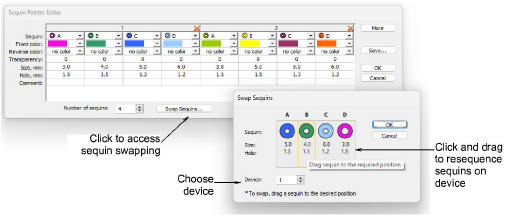
Wilcom EmbroideryStudio Digital Edition provides improved support for sequin/bead code mapping when exporting to machine file. This feature is designed to support Chinese brands of multiple sequin/bead devices. Mapping rules are specified by device manufacturers. EmbroideryStudio provides the flexibility to allow digitizers to set mapping rules according to device specifications.
Generally, sequins are fitted on the machine first and the sequin palette configured accordingly. Sometimes the design may be stitched on another machine with a different configuration. Rather than reconfiguring the machine, it’s much simpler to reconfigure the palette. The Sequin Palette Editor dialog now includes a Swap Sequins button which makes this possible.

EmbroideryStudio provides separate Drop Sequin and Drop Bead functions which are saved with the native EMB design file. However, when exporting to Tajima DST file format, both ‘Drop Sequin’ and ‘Drop Bead’ functions are replaced by Jump codes. If your design uses Dahao machine format, the machine file uses a modified protocol for non-standard use of Jump codes. This format is also used by some compatible controllers.

Currently, EmbroideryStudio supports up to eight (8) sequins and/or eight (8) beads per design. Some machines support up to sixteen (16) ‘slots’ per device. Any of these 16 slots can be used and mapped to 8 sequins and/or beads. Since sequins and beads are encoded the same way in the machine file, you need to map each to respective slots. You can now do this via the Save Options dialog.